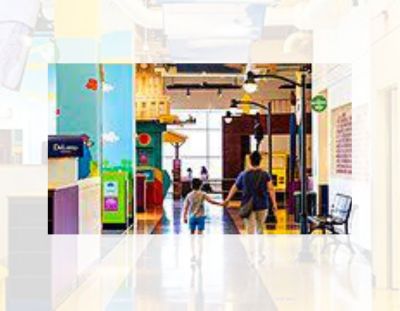Welcome to the Glazer Children’s Museum, a place where curiosity, creativity, and learning come together in a delightful experience for children and families. Located in the heart of downtown Tampa, Florida, this interactive museum offers an array of exciting exhibits and activities that cater to the interests and imaginations of children of all ages. Let’s embark on a journey through this wonderful destination, where education meets fun!

Glazer Children’s Museum Tampa Florida
- Engaging Exhibits: At the Glazer Children’s Museum, children are encouraged to explore, play, and learn through a series of hands-on exhibits. From the “Engineer’s Workshop” to “Central Bank,” “Art Smart,” and “Water’s Journey,” each exhibit is designed to spark curiosity and promote interactive learning. The museum’s play-based approach fosters creativity and critical thinking, making it an ideal place for children to discover their interests and talents.
- Adventure in “Central Bank”: Step into the world of finance and economics in the “Central Bank” exhibit. Here, kids can experience what it’s like to be a bank teller, customer, or even an economist. They’ll learn about currency, saving, and budgeting through engaging activities that teach valuable life skills in a fun and approachable manner.
- Unleashing Creativity in “Art Smart”: In the “Art Smart” exhibit, young artists can express themselves through various forms of art, such as painting, sculpting, and drawing. This space celebrates creativity and encourages children to explore their artistic abilities while gaining an appreciation for different art styles and techniques.
- Engineer’s Workshop: Budding engineers will love the “Engineer’s Workshop,” where they can tinker, build, and solve problems using real tools and materials. From constructing bridges to designing structures, this exhibit fosters a love for science, technology, engineering, and mathematics (STEM) subjects in an interactive and playful way.
- Water’s Journey: Learn about the importance of water conservation and environmental stewardship in the “Water’s Journey” exhibit. Children will embark on a virtual adventure through Florida’s unique water systems, understanding the significance of preserving this precious resource for future generations.
- Toddler Zone: Even the youngest visitors have a space to call their own at the Glazer Children’s Museum. The Toddler Zone offers a safe and stimulating environment for toddlers to explore, play, and learn at their own pace. Interactive playsets, sensory experiences, and age-appropriate activities ensure that the littlest visitors have a blast while developing essential skills.
- Special Programs and Events: Throughout the year, the museum hosts a variety of special programs and events, including educational workshops, cultural celebrations, and themed exhibits. From science demonstrations to storytelling sessions, these events add an extra layer of excitement to the already enriching museum experience.

Step into the enchanting realm of “Wonder Works” at the Glazer Children’s Museum, where young minds are transported to a universe of imagination and creativity. Wonder Works is an awe-inspiring exhibit specially designed to ignite the spark of curiosity and empower children to explore the world around them through immersive play and role-playing experiences. Let’s delve into the captivating world of Wonder Works and discover the magic it holds for children of all ages.
The Playful Playscapes:
Wonder Works is an interactive wonderland featuring a series of imaginative “playscapes” that simulate real-life scenarios. From a bustling grocery store to a vibrant restaurant, a captivating theater, and more, each playscape offers a unique and engaging environment for children to immerse themselves in.
As kids venture through these playscapes, they have the freedom to assume different roles, such as chef, shopper, actor, or customer. This role-playing experience fosters creativity, social skills, and empathy as children step into the shoes of others and explore various aspects of everyday life.
Nurturing Creativity and Confidence:
Within Wonder Works, creativity knows no bounds. Children are encouraged to let their imaginations soar as they interact with open-ended play areas and unleash their artistic expressions. Whether it’s designing a culinary masterpiece in the kitchen or creating a dramatic performance on stage, Wonder Works provides the canvas for young minds to paint their dreams.
Through imaginative play, children build self-confidence and gain a deeper understanding of their abilities. As they experiment with new ideas and problem-solving, they become more self-assured and open to exploring new challenges.
The Joy of Collaboration:
Wonder Works is also a hub for collaborative play. As children engage with one another in the different playscapes, they learn the value of teamwork, communication, and cooperation. Collaborative play nurtures essential social skills, teaching children to share, negotiate, and work together toward common goals.
This environment of positive social interaction enhances their ability to build lasting friendships and strengthens their sense of belonging within a community.
Real-World Connections
One of the most remarkable aspects of Wonder Works is how it bridges the gap between the imaginary and the real world. The exhibit mirrors familiar environments, allowing children to make connections between what they experience at the museum and their everyday lives.
By engaging in play that mirrors real-life situations, children develop a deeper understanding of the world around them. The hands-on experiences at Wonder Works prepare them to handle real-life scenarios with confidence and adaptability.
The Glazer Children’s Museum is more than just a place of fun and play; it serves as a bridge between the imaginative world within its walls and the real world outside. Through its exhibits and interactive experiences, the museum aims to create meaningful and practical connections for children, allowing them to apply their knowledge and skills in real-life situations. Let’s explore how the museum fosters these real-world connections and prepares young minds for success beyond the exhibits.
Hands-On Learning Experiences
The museum’s exhibits are designed to be hands-on and interactive, enabling children to actively engage with various concepts and subjects. Whether they’re experimenting with science in the Engineer’s Workshop, honing financial literacy in Central Bank, or expressing themselves through art in Art Smart, each exhibit offers practical experiences that mirror real-world scenarios.
By immersing themselves in these hands-on activities, children gain a deeper understanding of abstract concepts and see how they relate to everyday life. These hands-on learning experiences foster a love for learning and provide a strong foundation for future academic pursuits.
Problem-Solving and Critical Thinking
Throughout the museum, children are encouraged to think critically and solve problems independently. In Wonder Works, for example, they navigate real-life scenarios and make decisions as they take on various roles. This empowers them to become effective problem-solvers, equipping them with essential skills for tackling challenges in their lives.
The museum’s approach to problem-solving transcends the exhibits, preparing children to approach difficulties with creativity and adaptability in any situation.
Financial Literacy and Practical Money Management
In Central Bank, children are introduced to financial concepts in a fun and age-appropriate way. By engaging in role-play as bankers, shoppers, or merchants, they learn about the value of money, budgeting, and responsible spending.
These practical experiences instill a strong foundation of financial literacy from an early age, enabling children to make informed decisions about money and cultivate responsible money habits in the future.
Environmental Awareness and Conservation
The Water’s Journey exhibit takes children on a captivating exploration of water and its significance in the world. By engaging with topics like water conservation and understanding aquatic ecosystems, children become aware of the importance of preserving our natural resources.
Through hands-on activities and interactive displays, they discover how their actions impact the environment and how they can actively contribute to a sustainable future.
Social and Emotional Learning
The museum’s exhibits and collaborative play areas also foster social and emotional learning. As children interact with one another and engage in role-playing, they develop empathy, communication skills, and an understanding of emotions.
These social and emotional skills are essential for building positive relationships, resolving conflicts, and navigating social situations effectively, both within and outside the museum setting.
A Safe Space for Exploring Emotions
Wonder Works also provides a safe space for children to explore emotions and feelings. Through dramatic play and storytelling, children can express their emotions, fears, and dreams in a supportive environment.
This emotional exploration helps children develop emotional intelligence and empathy, fostering a greater understanding of themselves and others. Emotions are an integral part of being human, and understanding and expressing them is crucial for children’s emotional development. The Glazer Children’s Museum recognizes the significance of emotional exploration and has created a safe space within its exhibits to help children navigate their feelings. Let’s delve into how the museum’s compassionate approach fosters emotional intelligence and nurtures a deeper understanding of emotions.
Emotionally Engaging Exhibits
Throughout the museum, interactive exhibits are thoughtfully designed to evoke emotions and provide children with opportunities to express themselves. Whether it’s through art, storytelling, or role-playing, the exhibits encourage emotional engagement and open communication.
For example, art stations may offer materials for children to create artwork that reflects their emotions, allowing them to express themselves visually. Storytelling areas might present books or activities that delve into different feelings and experiences, providing a catalyst for discussing emotions with caregivers or peers.
Empathy and Social Skills
In the museum’s collaborative play areas, children have the chance to interact with others, fostering empathy and social skills. By engaging in imaginative play and understanding the emotions of fictional characters or fellow playmates, children develop empathy and learn to respond compassionately to the emotions of others.
The caring and supportive environment at the museum encourages children to connect with one another, strengthening their emotional bonds and building a sense of community.
Emotional Role-Modeling
The museum’s staff and volunteers play a crucial role in creating a nurturing environment for emotional exploration. Through their interactions with visitors, they model healthy emotional expression and provide positive reinforcement for children’s emotional growth.
When children witness adults validating and acknowledging their emotions, they feel more comfortable exploring and discussing their own feelings. This positive role modeling helps break down the stigma surrounding emotions and creates a space where children can be authentic and vulnerable.
Storytelling and Emotional Resilience
The power of storytelling is harnessed within the museum to address emotions and build emotional resilience. Storytelling sessions may focus on themes like overcoming fears, dealing with sadness, or expressing joy, enabling children to relate to characters and find comfort in shared experiences.
Through these stories, children learn that emotions are a natural part of life and that it’s okay to experience a range of feelings. This understanding lays the foundation for emotional resilience, empowering children to navigate challenges with greater confidence and adaptability.
Caregiver Engagement
The museum’s emphasis on emotional exploration extends to caregiver engagement. Special workshops and programs may be offered for parents and guardians to learn about fostering emotional intelligence in children.
By involving caregivers in the process, the museum reinforces the importance of emotional well-being as a shared responsibility between families and communities.
Conclusion
Wonder Works at the Glazer Children’s Museum is a universe of imagination where children are invited to play, dream, and create. As they embark on interactive adventures within the various playscapes, they develop essential life skills, build lasting memories, and cultivate a passion for learning.
Every visit to Wonder Works is a unique opportunity for children to become the architects of their own stories, fostering a lifelong love for exploration, discovery, and creativity. So, come and join the magical journey of Wonder Works, where the boundaries of imagination are boundless, and the possibilities are as endless as a child’s dreams.

